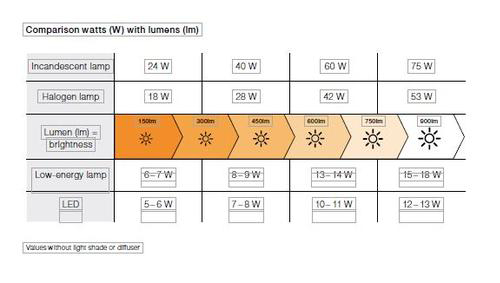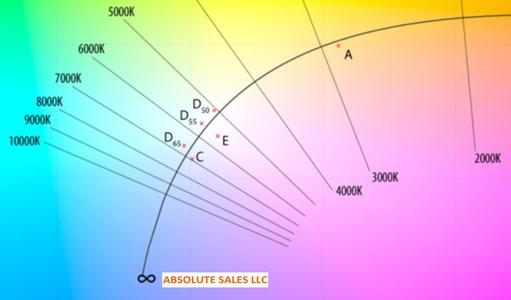LIGHTING 101
How does the distance from a light bulb affect the amount or quality of light?
CONSTANT - VARIABLE - RESULT
100 % @ 24" = 12.50 fc
100 % @ 32" = 9.60 fc
100 % @ 48" = 5.70 fc
Bright brains choose the right lamp once they are familiar with a few lighting terms.
Light Colour: Colour temperature also know as light colour, is specified in kelvins (K) and describes whether white light tends to be more yellowy warm or blueish cool. Warm white light is like late daylight. It looks welcoming and relaxing. Neutral white light has an activating effect, daylight white improves concentration. Colour temperatures up to 3500 K are referred to as warm white, over 3500 K as cool white.
LUMEN: (lm) is the unit of luminous flux, being the total amount of light given off by a lamp radiating in all directions. Lumens show what brightness to expect far more clearly than wattage (W).
LED Replacement Bulbs versus Fluorescent Bulbs
In recent years, the lighting industry has touted the benefits of T8 lighting. T8 has been one of the cheapest options out there for high bay and office lighting retrofits. New LED technology has just been too expensive; not only to purchase, but the installation was a significant cost as well.
Current market conditions have now changed. LED is definitely becoming more popular. Why? Because the industry has had time to “test” market the T8. T8 bulbs that were warranted for 3 years are failing at 2.5 years. T8’s were supposed to last 40,000 hours, well beyond 3 years, but several failed at 2.5 year mark. In the past few years, LED lighting has really come down in price, there are a lot more options for this newer technology and they are usually warranted for 5 years. So the question now is whether the current price differential is really worth it?
8 Reasons to Consider Direct Replacement LED Bulbs over Fluorescent Bulbs
1. LED Replacement Bulbs are 30% more efficient – You get more light from a LED replacement bulb, they use less wattage. LED replacement bulbs typically use 22 watt vs 28-32 watts with a T8 equivalent, making them 30% more efficient.
2. LED Transfers Light versus Heat - A LED fixture uses its energy to produce light. Most lighting sources, including fluorescent, use heat to generate light which is why traditional incandescent, metal halide and fluorescent are losing favor.
3. LED Makes Air Conditioning More Efficient - LED fixtures contribute little or nothing in regard to heat gain in a room or an air-conditioned space. The LED simply generates less heat. Less heat means the air-conditioning system does not have to work as hard. This can become extremely important if you are doing a new build or upgrade as you may be able to utilize smaller A/C systems to maintain comfort for the same square footage.
4. LED Does Not Emit UV - LED replacement bulbs do not emit any light in the non-visible light spectrum (UV). UV/IR light causes colors to fade in fabrics, signage, while also being the leading cause for eye strain and eye fatigue. Fluorescent T8 bulbs emit UV/IR light.
5. LED Replacement Bulbs contain no Mercury - One of the most important differences lies in the fact that there is no Mercury or Glass Content with LED lighting. For example: Out of 10 million lamps, these lamps hold roughly 400 pounds of toxic mercury waste. This waste goes into our landfills. It is estimated that only two out of 10 bulbs are effectively recycled. Source: State of Washington Environmental Protection Agency. Please see our “Industry Links” in the Reference Section for lamp recycling options and providers.
6. LED Still Give Off Light At End-Of-Life - A fluorescent bulb at the end of its life is very simple to spot. A T8 bulb is considered end-of-life at 60% of its light output, which equates to roughly 14,400 hours. LED replacement bulbs, on the other hand, calculate the end of life at 70% which is approximately 50,000 hours. In order to keep up with LED, you will have to replace the T8 bulbs 3.5 times.
7. LED Provides 70% More Light - The beam angle of the LED replacement bulb is 110 degrees. This means that all of the light generated by the LED bulb is focused in the 110 degree area. The T8 bulb on the other has a beam angle of 360 degrees. That means the majority of the light generated by the T8 bulb is going out the sides and top of bulb, which does not benefit the intended target.
8. LED is a Directional Light Source – Since the LED replacement bulbs emits light at a 110 degree pattern vs the 360 degree pattern given off by T8 fluorescent bulbs, only 30% of the light given off by the T8 fluorescent is actually hitting the intended target. Essentially, you are not using all available light because the fluorescent bulb is also lighting the fixture. That is the reason why fluorescent fixtures are brighter with reflectors
While the above statements are true, the T8 has been a tried and true staple in the industry. Barring maintenance, the T8 is predictable, available, and has a low initial cost. Every application may have a unique performance requirement. These reasons are simply provided as considerations when selecting your light source.


